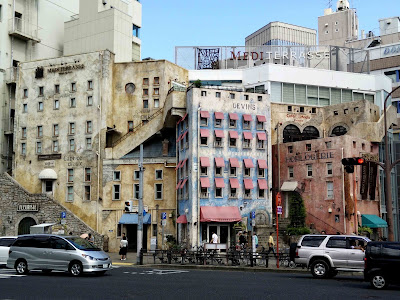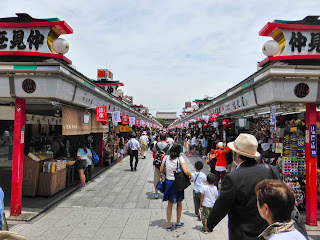After a
glorious, much needed rest from yesterday’s air travels and immediate jaunt
through central Tokyo, walking a solid 12 km through Shinjuku and Shibuya, it
was time to start my second day in Japan.
This
time I had a plan, to hit up Asakusa
and Sensō-ji temple, make my way
to Akihabara (the famous anime,
electronic, videogame, and all round subculture district of Tokyo), then finish
up the day at the Imperial palace.

Like most of my mornings in Japan, this one started with a nice, ice cold
coffee from a vending machine. Vending machines are everywhere in Japan
(another stereotype that proves true). Even as I was desperately lost in the back
alleys of residential Tokyo, I was never more than a block away from the
friendly glow of the vending machine. It was a brilliant convenience that I
wish more countries would adopt!
Arriving in Asakusa, a district
in Taitō,
I’m immediately met with a swarm of tourists, a sight I wasn’t yet familiar
with. It didn’t spoil the atmosphere (it was a Monday, so it wasn’t that busy),
but Tokyo had been so vacant yesterday it was a surprising sight. The Kaminarimon, a beautifully ornate ‘Thunder
Gate’ protected by Raijin and Fujin, was built in 941 CE as the
entrance to Sensō-ji.
Wandering
around the massive red lantern, you are immediately greeted by even more
tourists in, surprisingly, a long alley known as Nakamise-dori full of Japanese novelty wares and souvenirs.
Wandering past all the plastic waving ninja, geisha, and dragon toys you emerge
upon the absolutely stunning Sensō-ji
temple complex.
As Tokyo’s oldest temple, founded in 645 CE, you can’t help but
stare in awe at the Buddhist marvels. Unfortunately the majority of what stands
has been rebuilt, as fires destroyed the complex numerous times.
After doing the touristy thing and making a temple wish (I was lucky and
received a good/regular one… some are truly awful!), I moved on to the Dragon fountain to purify before
entering the temple.
Unfortunately, as I was travelling on my own, I naively
watched what I thought was a woman take a big swig of the fountain water, to… I
don’t know, inner purify. Little did
I know the ritual was to cleanse the lips
or if you drink you drink a small amount and/or spit it out. This I did not do,
I took a big ol’ gulp and let’s just say I was certainly inner purified.
Moving along. Before you enter the temple there is another chance to
cleanse and pray, with a large cauldron-like structure burning incense. The
temple’s inside was as ornate as the outer edifice, with gold glinting from
every angle. The rituals in temples is to toss a few coins, bow, clap twice,
pray, and bow again. By the end of my 3 months I was a temple pro, bow clap
bowing like a champ. Not sure my wishes have come true yet, but I imagine it’s
a slow process.
After hopping on the metro toward
Akihabara,
I noticed the unusual low hanging advertisements for the first, and not the
last, time.
I wouldn’t say things were really
small in Japan but for a roughly 6 ft man, I did have to duck a few times.

Stepping out into Akihabara you have
to wander a little before you get into the mess of things. Then suddenly, BAM,
all the buildings are covered in videogame characters, idols, and scantily clad
cartoons, it was brilliant! I had no idea what was going on and I was loving
it. Loud noises, traffic, explosions from the shops, and women in French maid
costumes trying to get you in to restaurants (more on that later)… Akihabara
is what the West thinks Japan looks like. Of course, this is one small district
that in no way represents Japan as a
whole, but man am I glad it exists… Don’t ever lose your quirk Japan!
I stop at a little lunch-joint in
Akihabara
where you put your money into a vending machine, you place your order by
choosing a button, receive a ticket, you then give that ticket to the chef
(sometimes a waitress), and within a
few
minutes you have hot and fresh food in front of you. This pork combination was
£4... and it was delicious. Fried pork, steamed rice (of course!), miso soup,
salad, mayonnaise, pickle… Oh my… I want it again. I was very surprised to see
mayonnaise, but the Japanese surprisingly use loads of mayonnaise!
After that lunch, it was time to walk to the Imperial Palace. Long story
short… I didn’t see it this day. I did however, have a lovely wander through
the Imperial Gardens which had some beautiful Japanese flowers I’d never seen
before.
After walking through the Imperial Chiyoda
district, back through Shibuya and Shinjuku, it was time for the evening
meal before retiring for the night. Tokyo tsukemen
was available in a little noodle-joint just around the corner, so why not… when
in Rome! This time with added semi-soft boiled eggs and pork slices, tonight’s
was a real winner.
 Arriving in Sannomiya
(via any one of three parallel train
lines) you are immediately greeted by the usual tall buildings and clean
advertising of ‘big city’ Japan. Like
many of the metro lines throughout Japan, the space surrounding the train lines
is not left wasted and decrepit, but is vibrant, busy, and full of life. Shops,
restaurants, and bars litter the undercarriage of the tracks, with long
stretches of what one could call a ‘strip-mall’.
Arriving in Sannomiya
(via any one of three parallel train
lines) you are immediately greeted by the usual tall buildings and clean
advertising of ‘big city’ Japan. Like
many of the metro lines throughout Japan, the space surrounding the train lines
is not left wasted and decrepit, but is vibrant, busy, and full of life. Shops,
restaurants, and bars litter the undercarriage of the tracks, with long
stretches of what one could call a ‘strip-mall’.  One popular area in Sannomiya
is Ikuta road which houses a plethora
of bars, clubs, and variety of shops. Selling all sorts of wares, from shoes (I
bought some Dragon’s beard shoes made
in Osaka), to triangular watermelons, to Kobe
beef, you’d find whatever you’re looking for.
One popular area in Sannomiya
is Ikuta road which houses a plethora
of bars, clubs, and variety of shops. Selling all sorts of wares, from shoes (I
bought some Dragon’s beard shoes made
in Osaka), to triangular watermelons, to Kobe
beef, you’d find whatever you’re looking for.






















































